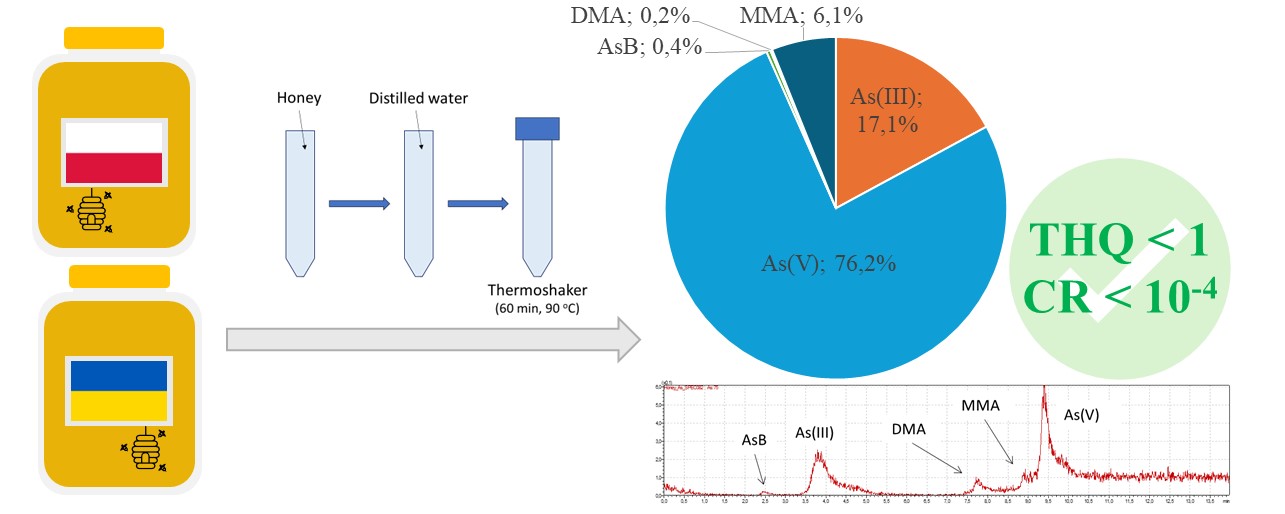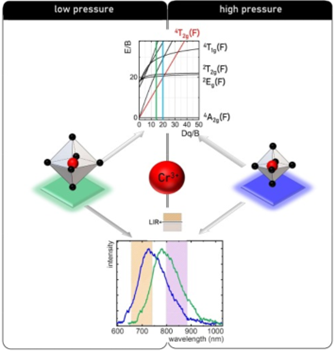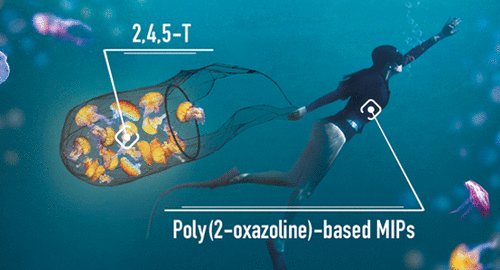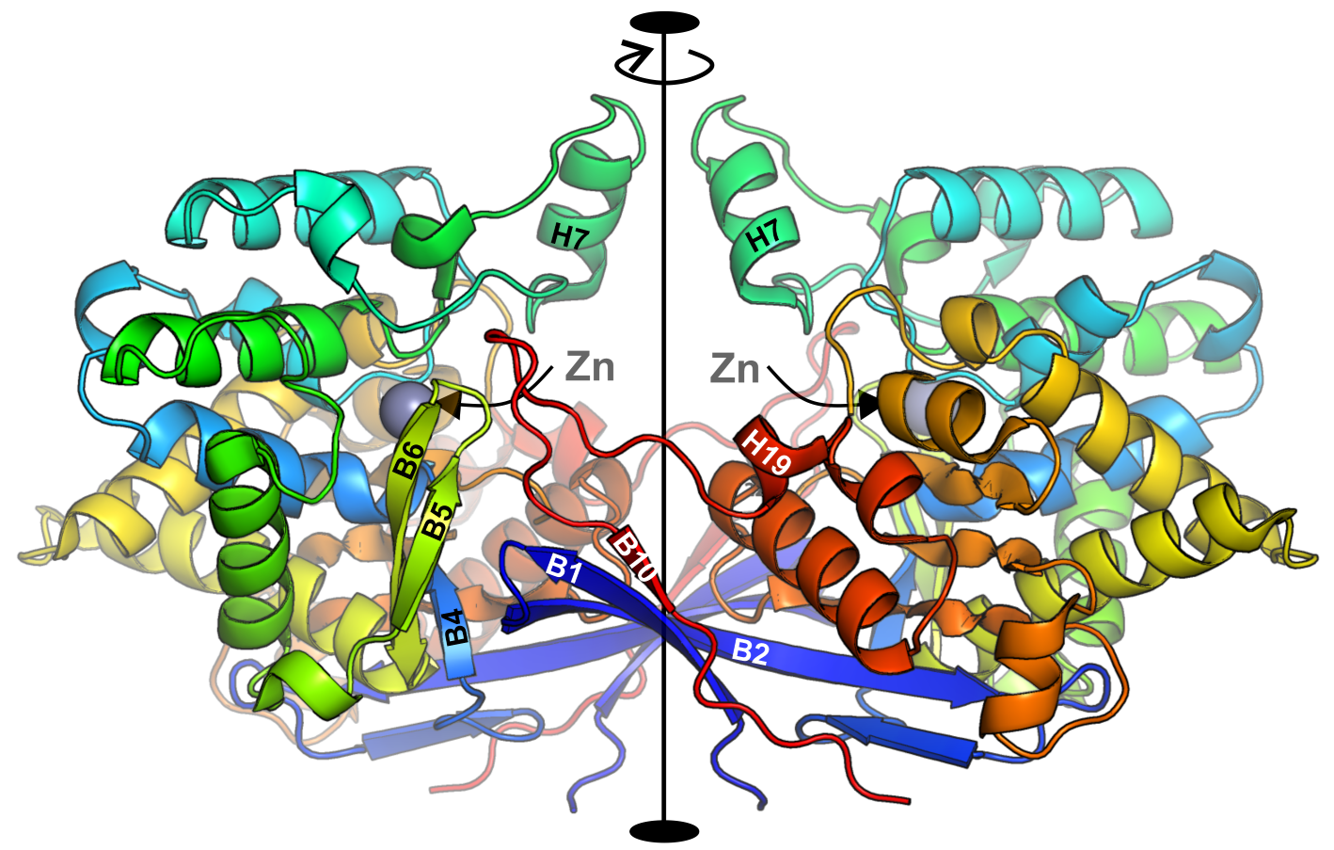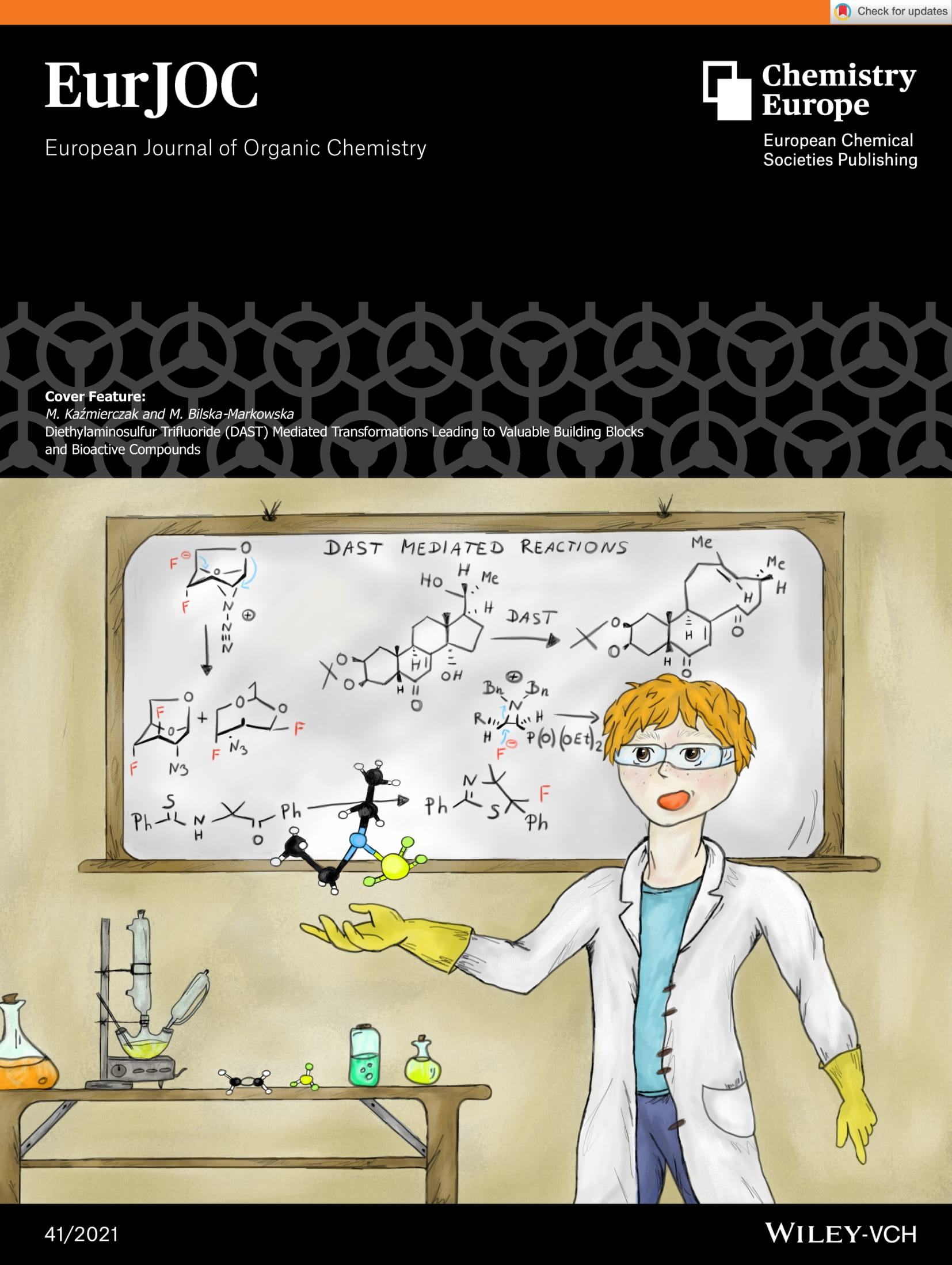List of 50 best-cited publications from the Faculty of Chemistry, Adam Mickiewicz University, according to the Web of Science
Recent Faculty Publications
- A paper titled "Persistent Photoluminescence and Mechanoluminescence of a Highly Sensitive Pressure and Temperature Gauge in Combination with a 3D‐Printable Optical Coding Platform" was published in the prestigious journal Advanced Science (IF = 15.1). This research is the result of fruitful collaboration among research groups from Poland, China, and Spain. The published findings describe the development of a multifunctional optical detection platform based on Sr₂MgSi₂O₇ doped with Eu²⁺ and Dy³⁺ ions, which exhibits three types of luminescence: mechanoluminescence, photoluminescence, and persistent luminescence. This combination enables highly sensitive remote measurements of temperature, pressure, and force. The developed Sr₂MgSi₂O: Eu²⁺/Dy³⁺ material can serve as a mechanoluminescent force sensor in the range of 3–30 N, thanks to a linear relationship between mechanoluminescence intensity and applied force. Furthermore, the full width at half maximum (FWHM) and the luminescence decay time of the developed phosphor respond significantly to temperature, leading to high temperature sensitivity in these parameters. Most notably, this is the first report on the use of persistent luminescence (afterglow) for pressure measurement, where its prolonged (measured in seconds) decay time serves as a manometric parameter. Therefore, the developed material can function as a highly sensitive, multimodal pressure sensor based on spectral band shift, bandwidth changes, and the lifetime of excited states. Through optimization of the developed phosphor, we successfully obtained doped polymers, which were then 3D-printed and demonstrated for applications in anti-counterfeiting, security visual markers, 8-bit optical coding, and QR codes.
T. Zheng, J. Luo, D. Peng, L. Peng, P. Woźny, J. Barzowska, M. Kamiński, S. Mahlik, J. Moszczyński, K. Soler-Carracedo, F. Rivera-López, H. Hemmerich, M. Runowski. Persistent Photoluminescence and Mechanoluminescence of a Highly Sensitive Pressure and Temperature Gauge in Combination with a 3D‐Printable Optical Coding Platform. Advanced Science, 2024, 2408686. DOI:10.1002/advs.202408686.
- We kindly inform about publication of paper in Materials Horizons (IF = 12.2) entitled: „Supersensitive visual pressure sensor based on the exciton luminescence of a perovskite material”. The paper is a result of fruitful collaboration of research groups from Poland, Taiwan and Spain, i.e.: I) Faculty of Chemistry, Adam Mickiewicz University in Poznań (Poland); II) Faculty of Physics, University of Gdańsk (Poland); III) Departamento de Física, Universidad de La Laguna (Spain); IV) Department of Chemistry, National Taiwan University (Taiwan).
- The paper “Seven-membered N-heterocycles as approved drugs and promising leads in medicinal chemistry as well as the metal-free domino access to their scaffolds” written by Aleksandra Leśniewska and Professor Piotr Przybylski has been published by European Journal of Medicinal Chemistry (Elsevier, IF=6,0; 140 pkt. MEiSW). The publication covers approved and investigated drugs containing structural fragment of azepan/azepine, which are discussed in terms of biological activity, pharmacokinetic parameteres and the targets. Compounds in which seven-membered ring containing a nitrogen atom plays a role of a pharmacophore were indicated. Stereochemistry of approved drugs and drug candidates was addressed as if it is often overlooked. Metal-free methods of domino (cascade) synthesis which enable the regio- and stereoselective synthesis of often complex systems containing azepane/azepine structural motif were summarized. Areas requiring development were indicated, both in modifications in terms of optimization of biological activity and metal-free cascade synthetic methods.
- In the Journal of Hazardous Materials - Volume 471, June 5, 2024, 134364; (IF=13.6) an article by our Faculty employees was published, written by PhD student Dorota Jakkielska, Professor Marcin Frankowski and Dr. Hab. Anetta Zioła-Frankowska, prof. university. Article titled "Speciation analysis of arsenic in honey using HPLC-ICP-MS and health risk assessment of water-soluble arsenic", presents for the first time the results of speciation analysis of arsenic in honey samples. The conditions used for speciation analysis of arsenic in the system of hyphenated HPLC-ICP-MS techniques allowed for the determination of five forms of arsenic during one analysis, including inorganic and organic forms in various honey samples. Moreover, the study assessed for the first time the potential risk to human health related to the presence of particular forms of arsenic in honey.
- We kindly inform about publication of our paper in the leading journal in the field of materials science, i.e. Advanced Funtional Materials (IF = 19), entitled: „Constructing [2.2]Paracyclophane‐Based Ultrasensitive Optical Fluorescent‐Phosphorescent Thermometer with Cucurbit[8]Uril Supramolecular Assembly”. The paper is a result of fruitful collaboration of research groups from Poland, China, Spain and Germany, i.e.: I) Faculty of Chemistry, Adam Mickiewicz University in Poznań, Poland; II) Hangzhou City University in China; III) Universidad de La Laguna in Spain; IV) Institute of Organic Chemistry, Karlsruhe Institute of Technology in Germany. In this study, we present a novel rational strategy involving supramolecular host-guest assembly and polymerization of [2.2]paracyclophane (PCP) based molecules with cucurbit[8]uril (molecular cage) to suppress the molecular motion and promote phosphorescence even at relatively high temperature. The rigid and hydrophobic cavity of the organic cage provide an ideal microenvironment to host PCP molecules, whichsignificantly enhanced the photophysical performance after complexation. The incorporation of the molecular cage into the resulting polymers leads to enhanced phosphorescence performance. Depending on the materials structure and their encapsulation in organic cavity, they exhibit either red- or blue-shift with temperature. Importantly, the obtained materials exhibit a large structure-dependent spectral shift and change of phosphorescence lifetimes with temperature, allowing development of novel, phosphorescence-based and purely organic optical thermometers.
Qiu X., Zheng T., Runowski M., Woźny P., Martín I.R. , Soler-Carracedo K., Espinosa Piñero C., Lebedkin S., Fuhr O., Bräse S. Constructing [2.2]Paracyclophane‐Based Ultrasensitive Optical Fluorescent‐Phosphorescent Thermometer with Cucurbit[8]Uril Supramolecular Assembly. Advanced Functional Materials, 2024, 2313517. https://doi.org/10.1002/adfm.202313517.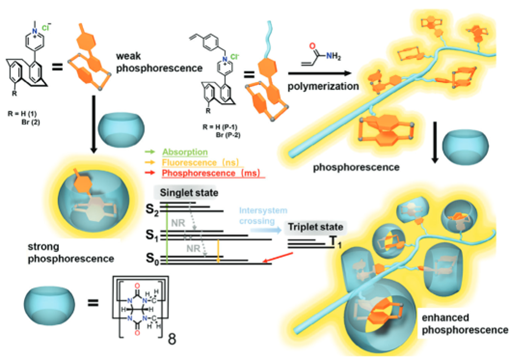
- We kindly inform you about the publication of our paper in Advanced Functional Materials (IF = 19), entitled: „Highly‐Sensitive, Tri‐Modal Luminescent Manometer Utilizing Band‐Shift, Ratiometric and Lifetime‐Based Sensing Parameters”. The paper is a result of fruitful collaboration of research groups from Poland and China, i.e., I) Department of Rare Earths, Faculty of Chemistry, Adam Mickiewicz University in Poznań (Poland); II) Institute of Low Temperature and Structure Research – INTiBS in Wrocław (Poland); III) Faculty of Physics, University of Gdańsk (Poland); IV) Jiangsu University of Science and Technology (China);. This publication concerns the development of a new luminescent pressure sensor Li3Sc2(PO4)3:Cr3+ based on chromium (III) ion emission. The developed pressure sensor can operate using up to three pressure parameters, namely, the shift of the emission line, the intensity ratio of bands, as well as luminescence decay times. Furthermore, the obtained material exhibits the highest sensitivity to pressure changes in the system among all known optical sensors, where pressure reading is based on the analysis of emission band spectral shift (dλ/dp = 23.9 nm/GPa) as well as changes in excited state lifetimes (SR = 93.56%/GPa).
Szymczak, M.; Jaśkielewicz, J.; Runowski, M.; Xue, J.; Mahlik, S.; Marciniak, L. Highly‐Sensitive, Tri‐Modal Luminescent Manometer Utilizing Band‐Shift, Ratiometric and Lifetime‐Based Sensing Parameters. Advanced Functional Materials, 2024. DOI: 10.1002/adfm.20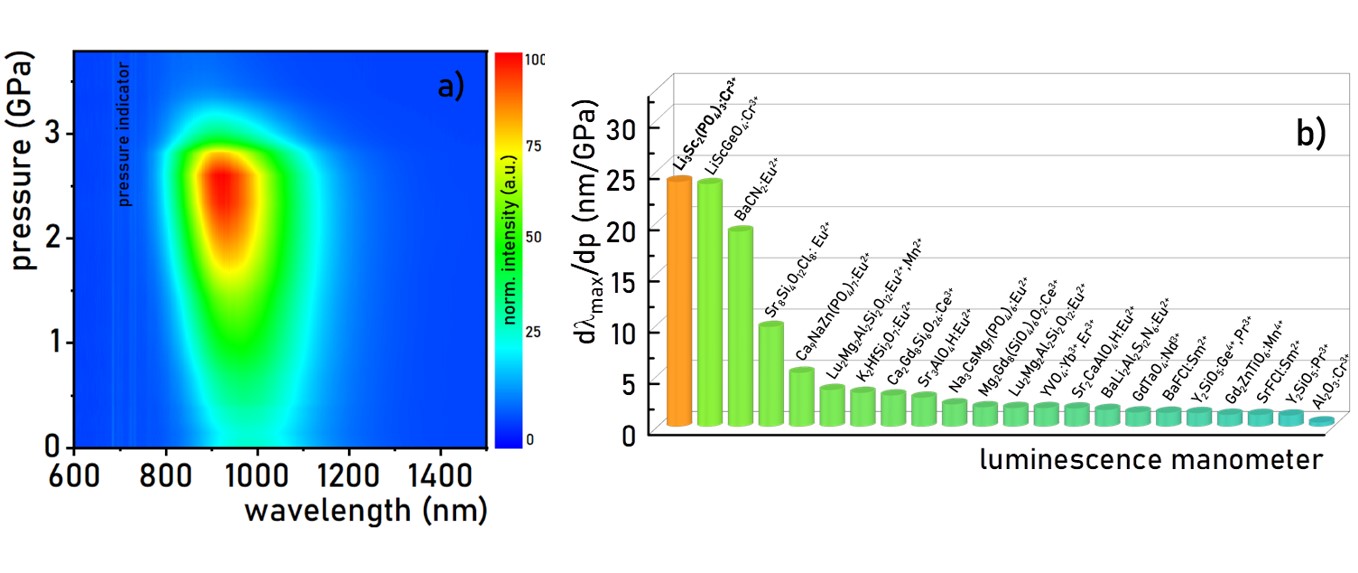
- We kindly inform about publication of our paper in Advanced Science (IF = 15.1), entitled: „Pressure‐Induced Remarkable Spectral Red‐Shift in Mn2+‐Activated NaY9(SiO4)6O2 Red‐Emitting Phosphors for High‐Sensitive Optical Manometry”. The paper is a result of fruitful collaboration of five research groups from Poland, China and Spain, i.e.: I) Department of Rare Earths, Faculty of Chemistry, Adam Mickiewicz University in Poznań (Poland); II) Institute of Low Temperature and Structure Research – INTiBS in Wrocław (Poland); III) Ningbo University (China); IV) Jiangsu University of Science and Technology (China); V) Departament of Fhysics, Universidad de La Laguna (Spain). This publication deals with development of new, ultra-sensitive optical (luminescent) pressure sensor based on Mn2+, exhibiting the highest pressure sensitivity (dFWHM/dP = 10.13 nm/GPa) among all currently reported optical manometers operating in a bandwidth mode.
- The combination of dendrimers, silsesquioxanes, and ferrocene units presents an intriguing departure from traditional silicon compound systems. A recent publication in the esteemed journal ACS Inorganic Chemistry titled "Metallodendrimers Unveiled: Investigating the Formation and Unique Features of Double-Decker Silsesquioxane-Based Silylferrocene Dendrimers" delves into this innovative realm. This publication emerged from an excellent collaboration with Prof. Pilar Garcia Armada from the Universidad Politécnica de Madrid, alongside Ola Mrzygłód, a Ph.D. student working under the guidance of Prof. UAM dr hab. Beata Dudziec (Faculty of Chemistry, CAT). Ola conducted this research during her internship in Madrid, which spanned over a few weeks. The paper describes the synthesis of DDSQ-based silylferrocene intriguing G1 and G2 dendrimers. Our investigation also encompassed the examination of their properties, incl. electrochemical behaviour.
Mrzygłód, A., Rzonsowska, M., García-Armada, M. P.; Dudziec, B.; Nowicki, M. Metallodendrimers Unveiled: Investigating the Formation and Unique Features of Double-Decker Silsesquioxane-Based Silylferrocene Dendrimers. Inorg. Chem. 2023. DOI: 10.1021/acs.inorgchem.3c02628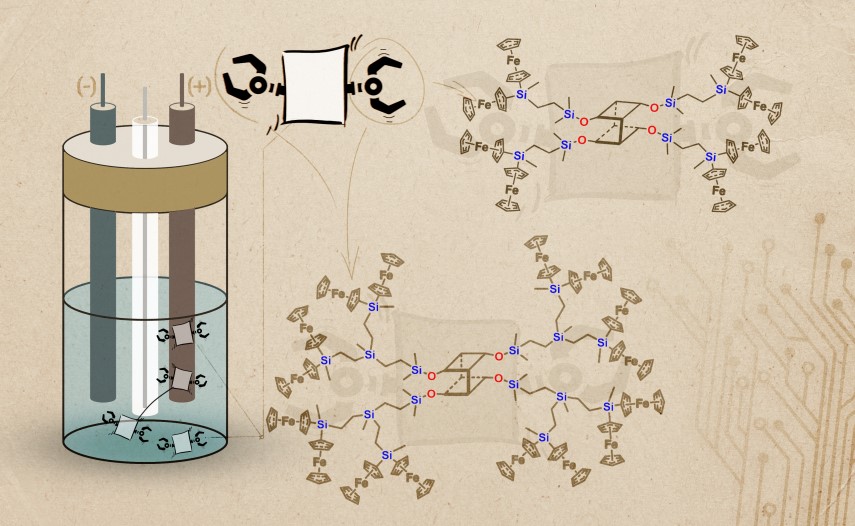
- We kindly inform about publication of our paper in the leading journal in the field of materials science, i.e. Advanced Funtional Materials (IF = 19), entitled: „Multimodal Optically Nonlinear Nanoparticles Exhibiting Simultaneous Higher Harmonics Generation and Upconversion Luminescence for Anticounterfeiting and 8‐bit Optical Coding”. The paper is a result of fruitful collaboration of research groups from Poland, China, Spain and USA, i.e.: I) Faculty of Chemistry, Adam Mickiewicz University in Poznań, Poland; II) Hangzhou City University in China; III) Universidad de La Laguna in Spain; IV) Łódź University of Technology in Poland; V) Harvard University in USA. The present study demonstrates the development and synthesis of first nanomaterials simultaneously exhibiting multiple non-linear optical (NLO) processes, i.e. second-harmonic generation (SHG), third-harmonic generation (THG), and up-conversion photoluminescence (UC-PL). The synthesized nanoparticles were incorporated in 3D-printable polymers, fibres and inks for anti-counterfeiting, fingerprints detection, biomedical applications and information processing. We also show-case the technological potential of these materials for security and optical data storage, by demonstrating the first realization of 8-bit fully non-linear optical en- and
- We kindly inform about publication of our paper in the leading journal in the field of materials science, i.e. Advanced Materials (IF = 32.086), entitled: „Mechanoluminescence And Photoluminescence Heterojunction for Superior Multi‐mode Sensing Platform of Friction, Force, Pressure And Temperature in Fibers And 3D‐printed Polymers”. The paper is a result of fruitful collaboration of research groups from Poland, China, Spain and USA, i.e.: I) Faculty of Chemistry, Adam Mickiewicz University in Poznań, Poland; II) Hangzhou City University in China; III) Universidad de La Laguna in Spain; IV) University of Houston in USA; V) University of Gdańsk in Poland; VI) University of Technology in Poland; VII) Shenzhen University in China. The present study demonstrates the development of a multifunctional sensing platform in a form of photo-/mechano-luminescent powder, fibers and 3D-printed polymers for optical detection of pressure, temperature, force and friction.
Zheng, T.; Runowski, M.; Martín, I. R.; Soler‐Carracedo, K.; Peng, L.; Skwierczyńska, M.; Sójka, M.; Barzowska, J.; Mahlik, S.; Hemmerich, H.; Rivera‐López, F.; Kulpiński, P.; Lavín, V.; Alonso, D.; Peng, D. Mechanoluminescence and Photoluminescence Heterojunction for Superior Multi‐mode Sensing Platform of Friction, Force, Pressure and Temperature in Fibers and 3D‐printed Polymers. Advanced Materials, 2023, DOI: 10.1002/adma.202304140.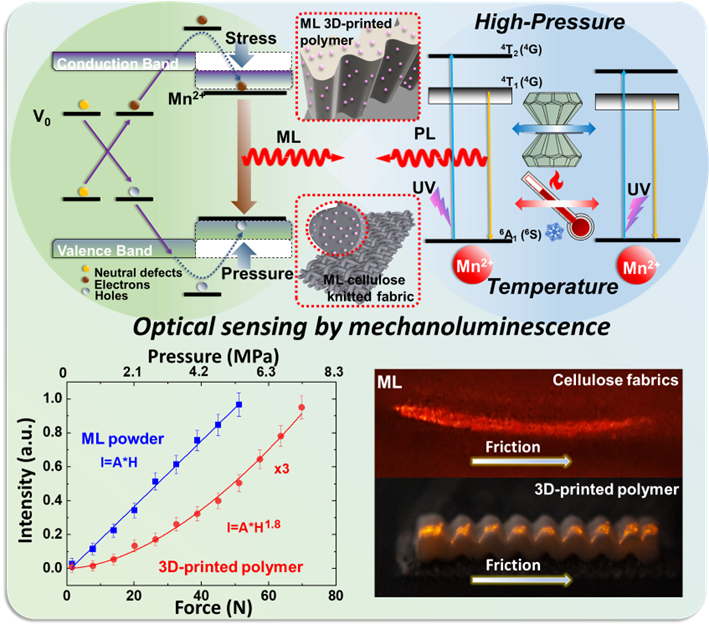
- The paper „Modifications of geldanamycin via CuAAC altering affinity to chaperone protein Hsp90 and cytotoxicity” has been published in the prestigious European Journal of Medicinal Chemistry (Elsevier, IF = 7.088, 140 pkt. MEiN) as a result of collaboration between prof. Przybylski Research Group and prof. Maria Gdaniec. The publication presents new modifications of geldanamycin, an ansamycin antibiotic with anticancer potency whose molecular target is the chaperone protein Hsp90. Modifications were performed via Huisgen 1,3-dipolar cycloaddition CuAAC at C(17) position. The geldanamycin’s benzoquinone core has been connected via a triazole linker with substituents (caps) of different nature – hydrophilic and hydrophobic, acidic and basic, which further allowed to perform structure-activity relationship (SAR) analysis. The anticancer activity of synthesized derivatives was discussed in view of docking modes with the target. Modifications of the geldanamycin scaffold resulted in decreased toxicity and dissociation constant with Hsp90 (Kd, increased affinity of the derivative to the target) and in increased apoptotic indices as well as anticancer potency on the μM level.
- The paper „Cascade Transformation of Ansamycin Benzoquinone Core into Benzoxazole Influencing Anticancer Activity and Selectivity” has been published by The Journal of Organic Chemistry (ACS, IF = 4.198, 140 pkt MEiN) as a result of collaboration between Professor Przybylski Research Group and Professor Maria Gdaniec. The publication presents a new cascade and metal-free method of benzoxazole synthesis from the benzoquinone systems and structurally diverse amines. The paper shows the influence of the base type and the nature of the amine reactant on the yield of the domino heterocyclization process. Based on biological studies it has been shown that tandem reduction of the benzoquinone core resulted in increased anticancer potency and selectivity indices determined in several cancer cell lines.
- Although water is a very simple compound from a chemist's point of view, its importance in nature cannot be overestimated. Suffice it to say that it constitutes as much as 60% of the human body weight, and its scarcity is one of the greatest problems affecting humanity. Despite the fact that water is one of the best-studied substances, its properties never cease to surprise.
- We kindly inform about publication of our paper in Advanced Functional Materials (IF = 19.924), entitled: „Giant Pressure‐Induced Spectral Shift in Cyan‐Emitting Eu2+‐Activated Sr8Si4O12Cl8 Microspheres for Ultrasensitive Visual Manometry”. The paper is a result of fruitful collaboration of three research groups from Poland, China and Spain, i.e.: I) Department of Rare Earths, Faculty of Chemistry, Adam Mickiewicz University in Poznań (Poland); II) Department of Microelectronic Science and Engineering, School of Physical Science and Technology, Ningbo University (China); III) Group of Optical Spectroscopy and High-Pressure, Departamento de Física - Universidad de La Laguna (Spain). This publication deals with development of new, ultra-sensitive optical (luminescent) pressure sensor, exhibiting the highest pressure sensitivity (dλ/dP = 9.7 nm/GPa) among all currently reported optical manometers.
Zheng, T.; Runowski, M.; Xue, J.; Luo, L.; Rodríguez‐Mendoza, U. R.; Lavín, V.; Martín, I. R.; Rodríguez‐Hernández, P.; Muñoz, A.; Du, P. Giant Pressure‐Induced Spectral Shift in Cyan‐Emitting Eu2+‐Activated Sr8Si4O12Cl8 Microspheres for Ultrasensitive Visual Manometry. Advanced Functional Materials, 2023, 2214663. DOI: 10.1002/adfm.202214663.
- The prestigious journal ACS Applied Materials & Interfaces (IF = 10,383, 200 pts. MEiN) published a paper entitled. "Noncentrosymmetric Lanthanide-Based MOF Materials Exhibiting Strong SHG Activity and NIR Luminescence of Er3+: Application in Nonlinear Optical Thermometry." The paper is the result of a fruitful collaboration between three research groups i.e., the Department of Rare Earths, Faculty of Chemistry, UAM; the Department of Functional Nanostructure Synthesis, Faculty of Chemistry, UAM; and the Optical and High Pressure Spectroscopy Group, Faculty of Physics, University of La Laguna, Spain. Taking advantage of the different sensor responses under changed thermal conditions, a nonlinear optical thermometer based on non-centrosymmetric Ln-MOF (Lanthanide Metal-Organic Frameworks) - doped MOF-Yb3+/Er3+ material was developed. In the presented system, the intensity of the SHG (Second Harmonic Generation) signal decreases with increasing temperature, while the emission band of Er3+ ions in the NIR broadens slightly, enabling ratiometric temperature monitoring by measuring the change in the intensity ratio of Er3+/SHG emission bands (1550 nm/488 nm). Moreover, the presented non-centrosymmetric system can be synthesized from achiral substrates, in a high-throughput hydrothermal synthesis process using only a metal salt and an organic solvent, which significantly simplifies access to this group of compounds. Our research provides a basis for the rational design of easily accessible and self-monitoring NLO-active Ln-MOFs with desirable optical and electronic properties.
Runowski M., Marcinkowski D., Soler-Carracedo K., Gorczyński A., Ewert E., Woźny P., Martín, I. R. Noncentrosymmetric Lanthanide-Based MOF Materials Exhibiting Strong SHG Activity and NIR Luminescence of Er3+: Application in Nonlinear Optical Thermometry. ACS Appl. Mater. Interfaces 2023, 15, 2, 3244–3252. DOI: 10.1021/acsami.2c22571 - The prestigious scientific journal Chemical Engineering Journal (IF = 16.744) has published a work entitled "Temperature invariant ratiometric luminescence manometer based on Cr3+ ions emission". The work was published as a result of fruitful cooperation between three research groups, i.e., the Department of Rare Earths, Faculty of Chemistry, Adam Mickiewicz University in Poznań; Institute of Low Temperature and Structure Research, Polish Academy of Sciences in Wrocław; Optical and High Pressure Spectroscopy Group, Faculty of Physics, University of La Laguna, Spain. The research paper concerns the development of an optical high pressure sensor based on the Li2Mg3TiO6 matrix doped with optically active Cr3+ ions. The basis for the development of the contactless, luminescenct manometer was the emission band of the radiative transition 4T2→4A2 with a high value of the spectral shift (Δλ ≈ 70 nm) under the high-pressure conditions up to 7.75 GPa. The changes in the luminescence intensity ratio (LIR) for emission band in the two spectral ranges (i.e. 825 - 935 nm and 1005 - 1095 nm) made it possible to determine the linear change of the LIR parameters and to correlate it with the pressure value in the system. Additionally, the LIR analysis under the changed temperature conditions (123 - 543 K) showed a slight (approx. 5%) change in the value of the LIR parameter, which enables pressure measurement regardless of temperature fluctuations in the system.
- The paper „Structural diversity and biological relevance of benzenoid and atypical ansamycins and their congeners” by Natalia Skrzypczak and Prof. Piotr Przybylski has been published in Natural Product Reports (Royal Society of Chemistry, IF = 15.111, 200pkt. MEiN). The article was highlighted as the front cover of the current issue. The publication presents the classification and structural features of benzenoid ansamycins and describes their biosynthetic pathways led by bacteria. The enormous diversity of natural benzenoid ansamycins is the result of not only the biosynthesis of these compounds by bacteria, but also various muta- and semi-synthetic approaches that enable the assembly of various types of ansamycin bridges with structurally diverse cores. The study also discusses the attractive anticancer activity of this type of ansamycins in relation to their molecular targets (heat shock proteins, tubulins) and problems related to cytotoxicity to healthy cells. Review article, also based on the achievements of the Team of prof. Przybylski, shows some opportunities in optimizing the anticancer activity of this type of natural products with reduced toxicity created by new hybrid synthetic strategies, chemical (semisynthesis) and biological (mutasynthesis).
- The paper „Modifications, biological origin and antibacterial activity of naphthalenoid ansamycins” by Natalia Skrzypczak and Prof. Piotr Przybylski has been published in Natural Product Reports (Royal Society of Chemistry, IF = 15.111, 200 pkt. MEiN). The structures of ansamycin antibiotics discussed in the review also became a front cover of the current issue of the journal. The publication presents the structural division of natural naphthalenoid ansamycins according to the type of core and length of the ansamycin chain, as well as ansamycins biosynthetic pathways. The enormous diversity of the naphthalenoid ansamycin biosynthetic pathways translates into the structural diversity of the ansamycin bridges or the naphthalenoid cores. The paper discusses and compares the biological activity of natural and semisynthetic naphthalenoid ansamycins in relation to their molecular targets (binding sites in bacterial cells). The high antibacterial activity of naphthalenoid ansamycins seems to be depended on the length and conformational lability of the ansa chain - the higher the flexibility of the ansa bridge, the higher the antibacterial potency, while intramolecular equilibria such as the zwitterionization of the ansamycin scaffolds, are also important, as evidenced i.a. by studies performed in the Team of prof. Przybylski.
- In August the book "Perfluoroalkyl Substances: Synthesis, Applications, Challenges and Recipes" has been published by the Royal Society of Chemistry Publishing. The author of one of the chapters is Prof. UAM dr. hab. Justyna Walkowiak-Kulikowska. This chapter presents essential information on per- and polyfluoroalkyl substances (PFASs) and a brief historical overview and ways of classification and discusses their chemical structures and also their physicochemical, mechanical, thermal and surface properties. Furthermore, it elaborates on general synthetic methods used for preparing PFASs and provides examples of their wide applications in numerous advanced industrial and common consumer products.
- We kindly inform about publication of new paper in Chemical Engineering Journal(IF = 13.273), entitled: „ Highly-efficient double perovskite Mn4+-activated Gd2ZnTiO6 phosphors: A bifunctional optical sensing platform for luminescence thermometry and manometry”. The paper is a result of fruitful collaboration of three research groups from Poland, China and Spain, i.e.: I) Department of Rare Earths, Faculty of Chemistry, Adam Mickiewicz University in Poznań (Poland); II) Department of Microelectronic Science and Engineering, School of Physical Science and Technology, Ningbo University (China); III) Group of Optical Spectroscopy and High-Pressure, Departamento de Física - Universidad de La Laguna (Spain). This publication deals with development of first, bifunctional optical sensor of high pressure and temperature, based on the emitting properties of the d-block metal ions, i.e., perovskites containing optically active Mn4+ ions.
- The paper by Daniel Łowicki and Piotr Przybylski “Cascade synthetic strategies opening access to medicinal-relevant aliphatic 3- and 4-membered N-heterocyclic scaffolds” has been published in European Journal of Medicinal Chemistry (IF = 6.514). Cascade (domino) reactions are one of the modern trends in organic synthesis as they are inspired by the processes occurring in nature. The cascade synthesis allows to perform several following transformations in a ‘one pot’ by mixing all reagents at ones, and without isolation of the intermediates. In each precisely planned step a newly formed functional group is able to react with another molecule or functional group present within the molecule, just like domino blocks. In this review paper the application of the tandem reactions for the synthesis of small aliphatic three-membered as well as four-membered rings is summarized. Synthesis of saturated 3- and 4-membered rings is challenging due to the ring strain. Nevertheless, they are essential pharmacophores present in many approved drugs, as well as those in the clinical trials. The aim of this study is to compare the cascade synthesis of modified aziridines, azirines, azetidines and azetidinones (β-lactams) with the biological activity of the molecules that contain such cyclic scaffolds. This review represents an interdisciplinary approach combining biological and medical applications with modern cascade synthesis of small ring-containing molecules, and therefore it may be useful inspiration for these scientists who are looking for new potential drugs, as well as those working on simple and efficient methods of their synthesis.
- We kindly inform about publication of our paper in Chemical Engineering Journal(IF = 13.273), entitled: „Pressure-Triggered Enormous Redshift and Enhanced Emission in Ca2Gd8Si6O26:Ce3+ Phosphors: Ultrasensitive, Thermally-Stable and Ultrafast Response Pressure Monitoring”. The paper is a result of fruitful collaboration of research groups from the Department of Rare Earths, Faculty of Chemistry, Adam Mickiewicz University in Poznań (Poland) and the Group of Optical Spectroscopy and High-Pressure, Departamento de Física - Universidad de La Laguna (Spain). This publication deals with development of new, ultra-sensitive optical pressure sensor, exhibiting the highest pressure sensitivity (dλ/dP = 3 nm/GPa) among all currently reported luminescent gauges.
- The paper "Copper Supported on Ceria Mesocellular Foam Silica as an Effective Catalyst for Reductive Condensation of Acetone to Methyl Isobutyl Ketone" by the teams: K. Grzelak, M. Trejda from Department of Heterogeneous Catalysis at the Faculty of Chemistry, AMU and A. Riisager from Centre for Catalysis and Sustainable Chemistry, Department of Chemistry, Technical University of Denmark was published in ChemSusChem journal (IF = 8.928). The production of methyl isobutyl ketone (MIBK) from acetone in one single process using Cu/Ce-MCF catalyst was proposed. A very good performance of the new catalytic system was explained by the presence of basic sites coming from ceria, necessary for the condensation of acetone to diacetone alcohol (DAA), Lewis acidity of the Cu2+ species required for the dehydration of DAA to mesityl oxide (MO) and presence of Cu0 centers active for the hydrogenation of MO to MIBK. The Cu/Ce-MCF catalyst had better catalytic performance and similar durability during continuous operation for 24 h as a preferred Pd/Ce-MCF catalyst recently reported in literature, implying that Cu can efficiently replace the noble metal Pd as active catalyst inventory for selective acetone condensation to MIBK.
- Tandem reactions (cascade or domino) are an important alternative for traditional organic synthesis. The advantage of these reactions is the absence for the need of isolation and purification of intermediates after each subsequent step, as the well as often higher yield and lower cost in comparison to multistep total synthesis. Due to the features, tandem reactions meet the role of ‘green chemistry’. In this review published in w European Journal of Medicinal Chemistry (IF = 6.514), the application of tandem reaction for the synthesis of pyrrolidine rings has been demonstrated. The pyrrolidine ring is an important pharmacophore present in nearly 100 approved drugs and many new biologically active compounds discovered in recent years. The application of cascade reactions for the synthesis of biologically active pyrrolidine derivatives is very limited. In contrast to already published reviews on 5-membered N-heterocyclic rings, which are focused mainly on synthetic reactions or biological activities, this work combines both of these threads and shows the utility of the tandem strategy for the construction of potentially active molecules containing pirrolidine pharmacophores as a central motif.
- The paper " An approach to modify 14-membered lactone macrolide antibiotic scaffolds" by the team A. Janas, K. Pyta, and P. Przybylski from Department of Chemistry of Natural Products and Professor M. Gdaniec at the Faculty of Chemistry was published in Journal of Organic Chemistry (IF= 4.354). The publication shows the synthesis of a ketolide derivative with the inverted configuration (12R) via a novel ketene acetal in acidic conditions. The structure of this atypical β-ketene acetal intermediate within the macrocyclic system has been determined by NMR and X-ray methods. The use of basic conditions at an elevated temperature yielded new, doubly α,β-unsaturated ketone macrolide derivatives with (4E) -configuration as two conformational isomers of folded-in or folded-out conformations. This work was supported by the Polish National Science Centre (NCN) under Grant Opus 10 no. 2015/19/B/ST5/00231.
Janas A, Pyta K., Gdaniec M., Przybylski P, An approach to modify 14-membered lactone macrolide antibiotic scaffolds Journal of Organic Chemistry 2022,87 (5), 3758-3761; DOI: 10.1021/acs.joc.1c02799
- The paper " Regioselective approach to colchiceine tropolone ring functionalization at C(9) and C(10) yielding new anticancer hybrid derivatives containing heterocyclic structural motifs " by the team K. Pyta, N. Skrzypczak and P. Przybylski from Department of Chemistry of Natural Products at the Faculty of Chemistry was published in Journal of Enzyme Inhibition and Medicinal Chemistry (IF= 5.051). The publication shows the influence of base type, temperature, and solvent on regioselective C(9)/C(10) modifications within the tropolone ring of colchiceine. New ether derivatives of colchiceine, bearing alkyne, azide, vinyl, or halide aryl groups enable assembly of the alkaloid portion with heterocycles or important biomolecules such as saccharides, geldanamycin or AZT into hybrid scaffolds by dipolar cycloaddition (CuAAC) or Heck reaction. Biological studies reveal that the bulkiness of the substituents and the substitution pattern of the tropolone proved to be essential for simply ether derivatives and that expanding the ether arms by terminal basic heterocycles as quinoline or pyridine, decreases the toxicity in HDF cells at high anticancer potency. This work was supported by the Polish National Science Centre (NCN) under Grant Opus 13 no. UMO-2017/25/B/ST5/00291.
Pyta K., Skrzypczak N.,Ruszkowski P, Bartl F., Przybylski P, Regioselective approach to colchiceine tropolone ring functionalization at C(9) and C(10) yielding new anticancer hybrid derivatives containing heterocyclic structural motifs. Journal of Enzyme Inhibition and Medicinal Chemistry 2022,37 (1), 597-605; DOI: 10.1080/14756366.2022.2028782
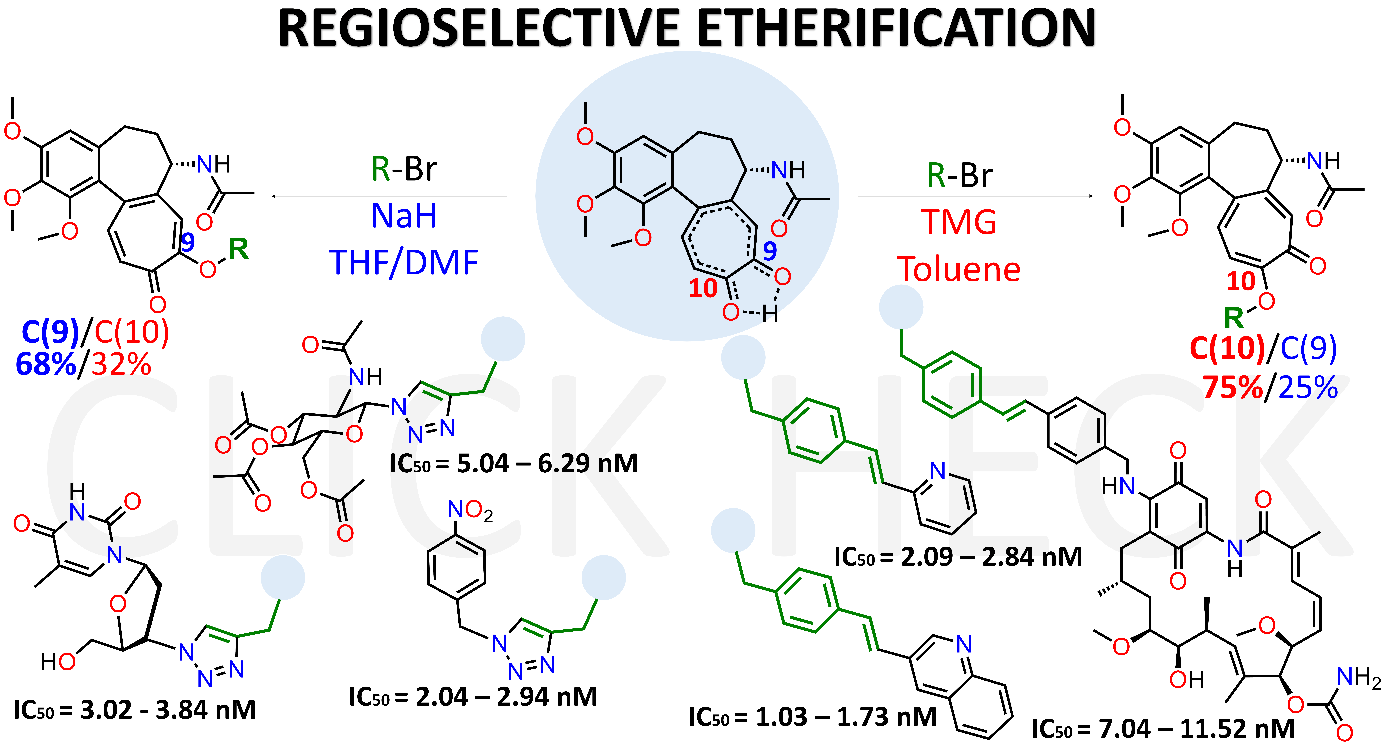
- The paper "Molecularly Imprinted Polymers with Enhanced Selectivity Based on 4 (Aminomethyl) pyridine-Functionalized Poly (2-oxazoline)s for Detecting Hazardous Herbicide Contaminants" by the teams: M. Cegłowski, G. Schroeder from Department of Supramolecular Chemistry at the Faculty of Chemistry, AMU and Y.W. Marien, S. Smeets, L. De Smet, D.R. D'hooge, R. Hoogenboom from Supramolecular Chemistry Group, Department of Organic and Macromolecular Chemistry, Ghent University was published in Chemistry of Materials journal (IF = 9.811). The publication presents an innovative method for the determination of 2,4,5-trichlorophenoxyacetic acid (2,4,5-T) in water with the use of molecularly imprinted poly(2-oxazoline) polymers (MIP) combined with mass spectrometry performing sample ionization under ambient conditions using FAPA (Flowing Atmospheric - Pressure Afterglow) technique. The synthesis method and complete characteristics of the molecularly imprinted polymers functionalized with pyridine derivative (4-AMP) and the mechanism of interaction of the analyte with the receptors present in the structure of polymers are presented. The use of MIP adsorbents as materials concentrating the analyte in the determination of 2,4,5-T in water and the FAPA-MS method allows the determination of this herbicide at the nanomolar level.
- The team from the Laboratory of Functional Nanostructures (M.Sc. Marcin Konopka and Prof. Artur R. Stefankiewicz) have just published a paper in Scientific Reports (IF = 4.379). An unorthodox approach to dynamic covalent chemistry has been described. A single building block was used to generate a library of numerous disulfide-based architectures in a one-pot single-step process. The initially-unexpected in-situ hydrolysis of a bis-imide was employed to control the composition of a library of structurally diverse macrocycles. The dual-stimuli method is based on simultaneous changes in pH and DMSO concentration to expand the structural diversity of the macrocyclic products. It is a facile strategy for the synthesis of water-soluble, multicomponent and highly functionalized dynamic macrocycles, thus giving a prospect of their application in guest-driven phase transfer.
- A research paper authored by dr Monika Rzonsowska, MSc Katarzyna Mituła, MSc Julia Duszczak, dr Małgorzata Kasperkowiak, dr Rafał Januszewski, dr Anita Grześkiewicz, prof. Maciej Kubicki, MSc Daria Głowacka and prof. AMU dr hab. Beata Dudziec has been published in Inorganic Chemistry Frontiers (IF = 6.569). The paper discloses an unexpected Si-O-Si cage reorganization that was observed during the standard hydrolytic condensation procedure of tetrasilanol double-decker silsesquioxane (DDSQ) with respective mono- and di-chlorosilanes. A deeper look into the process to find out its possible mechanism was performed – a series o analytical techniques was used, incl. NMR, MALDI and ESI MS analysis along with the thorough verification of crystallographic structures (11 examples) of obtained silsesquioxanes. The resulted compounds were also verified in terms of their thermal stability. Also, the unusual behaviour of vinyl-substituted DDSQs in the silylative coupling reaction was revealed. These results 5are a significant contribution to the development of research on specific organosilicon compounds, such as silsesquioxanes, and in particular on the still not fully recognized DDSQ systems.
Rzonsowska M, Mituła K, Duszczak J, Kasperkowiak M, Januszewski R, Grześkiewicz A, Kubicki M, Głowacka D, Dudziec B. Unexpected and frustrating transformations of double-decker silsesquioxanes. Inorg. Chem. Front. 2021. doi:10.1039/d1qi01363g.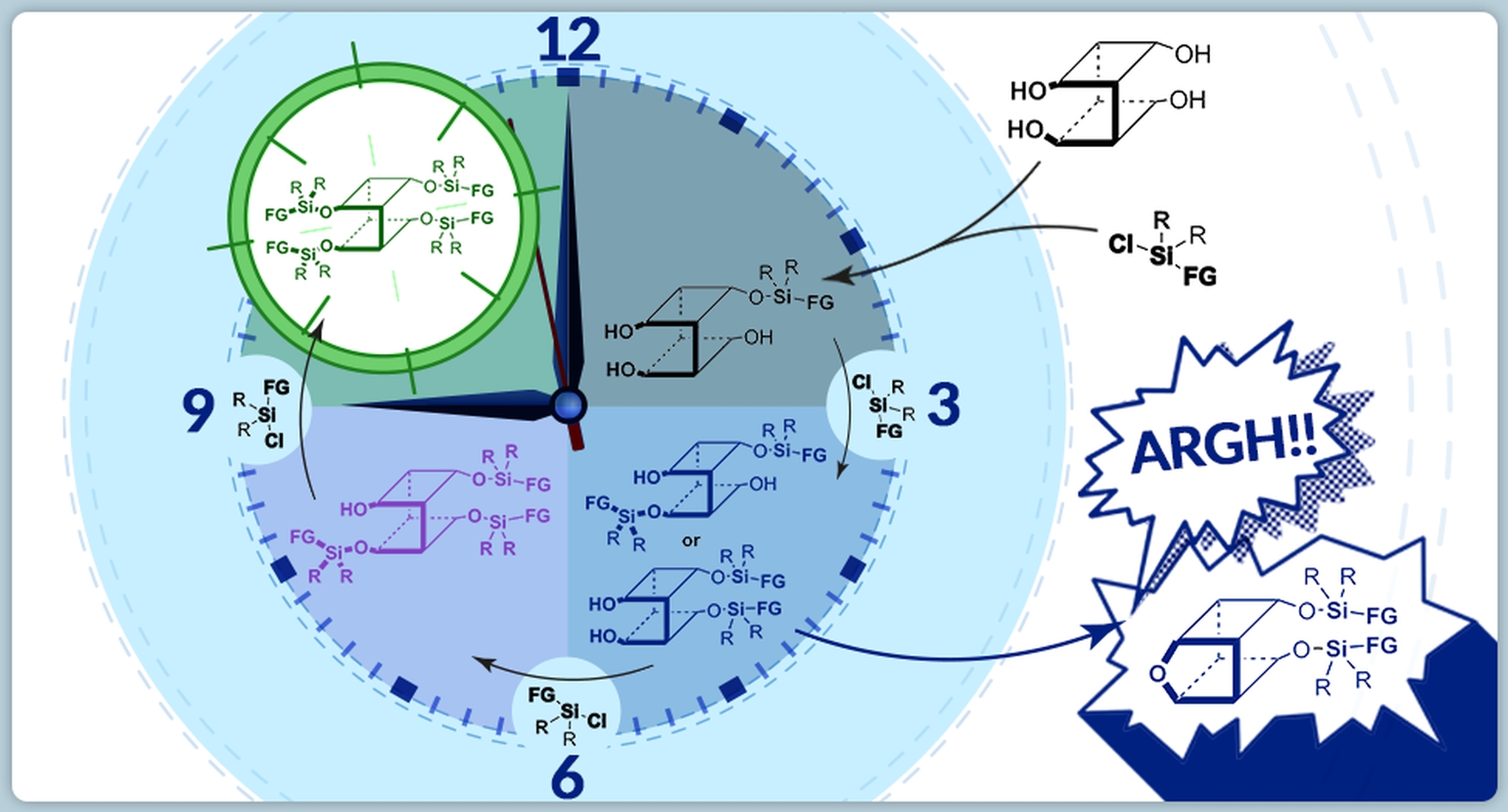
- The cooperation between two research teams i.e. the Laboratory of Functional Nanostructures (dr Anna Walczak, M.Sc. Gracjan Kurpik and Prof. Artur R. Stefankiewicz) and the Laboratory of Organometallic Catalysis (dr Maciej Zaranek, Prof. Piotr Pawluć) has led to the publication in the Journal of Catalysis (IF = 7.920). This article presents the synthesis and thorough spectro-structural characterization of the isomeric C,N-cyclopalladated complexes, in which two molecules of a flexidentate pyridyl-β-diketonate ligand simultaneously coordinate to the metal centre in two different modes - κ2O,O' and κ1C,κ1N. Both these isomers proved to be efficient (pre)catalysts for Heck reaction under relatively mild conditions and with low catalyst loading. Remarkable chemo- and stereoselectivity in cross-coupling of functionalized olefins with a broad scope of commercially available aryl iodides has been reported.
Walczak A, Kurpik G, Zaranek M, Pawluć P, Stefankiewicz A. R.; C(sp3),N palladacyclic complexes bearing flexidentate ligands as efficient (pre)catalysts for Heck olefination of aryl halides. J. Catal., 2022, 405, 84-90. doi: 10.1016/j.jcat.2021.11.033
- A recent paper in Nature Communications reports the discovery of the structure of a new enzyme (ReAV) splitting the amino acid asparagine into aspartate and ammonia. Enzymes with this function, called asparaginases, are urgently needed in medicine since under certain conditions they make excellent drugs for treating acute childhood leukemia. ReAV does not meet the criteria of a perfect drug but its structure allows molecular engineering aimed at fulfilling these conditions. The structure of ReAV is completely new in the asparaginase field. Its discovery crowns a 20-year effort of a research team led by Prof. Mariusz Jaskólski.
- The team from the Laboratory of Functional Nanostructures (M.Sc. P. Cecot, dr A. Walczak, dr G. Markiewicz and Prof. A. R. Stefankiewicz) published an article in Inorganic Chemistry Frontiers (IF = 6.569), about the synthesis of new metallosupramolecular systems (M4L6 tetrahedral cages, M2L2 macrocycles and MLn mononuclear complexes) bearing the photoactive azobenzene units. The article presents the reversible switching between three types of structures by changing the stoichiometry of the reaction mixture or by the addition of a competing amine. The presented research has shown, that the photoactivity of azobenzene moieties within the organic ligand can be effectively gated upon the addition of d-electron metal ions, by trapping the ligand within rigid metallosupramolecular architectures.
Cecot P, Walczak A, Markiewicz G, Stefankiewicz A. R.; Gating the photoactivity of azobenzene-type ligands trapped within a dynamic system of an M4L6 tetrahedral cage, an M2L2 metallocycle and mononuclear MLn complexes. Inorg. Chem. Front., 2021, doi.org/10.1039/D1QI01063H
- The work of dr Marcin Kaźmierczak and dr Monika Bilska-Markowska from Department of Synthesis and Structure of Organic Compounds has been published in European Journal of Organic Chemistry. Minireview shows some of the transformations of molecules using diethylaminosulfur trifluoride (DAST). This publication reveals that DAST does not only act as a fluorinating reagent, which as a result of nucleophilic substitution replaces the hydroxyl group with a fluorine atom but is also a mediator of other processes. It participates in rearrangement and cyclization reactions, resulting in valuable heterocyclic compounds, both fluorinated and non-fluorinated. Thus, it leads to significant building blocks as well as biologically active molecules.
- Daria Brykczyńska, a second-year PhD student from the Department of Synthesis of Functional Nanostructures, is a co-author of a publication that appeared in the journal Angewandte Chemie International Edition "Desulfonative Suzuki–Miyaura Coupling of Sulfonyl Fluorides" (https://doi.org/10.1002/anie.202111977). The published work concerns the Suzuki-Miyaury coupling, where it was reacted with aryl sulfonyl fluorides, which are usually inert to transition metal catalysis. Interestingly, the paper presents the results of research confirming the receipt of the expected product also without the addition of a base, and even in a strongly acidic environment, which further proves the uniqueness of the published results carried out in the research group of Prof. Joseph Moran at the Institut de Science et d'Ingénierie Supramoléculaires in Strasbourg in which the PhD student completed a scientific internship.
- The team of scientists from Department of Rare Earths has published the paper in Advanced Optical Materials
(IF = 9.926), concerning development of bifunctional, luminescent sensor of high-pressure and temperature, based on the emission features of thulium ion (Tm2+), at its unusual +2 oxidation state. Such sensor allows monitoring of high-pressure to at least 13 GPa, and temperature of the system in the range from 10 to 400 K, using various spectroscopic parameters, such as band intensity ratios, spectral shift, emission line width or luminescence lifetimes. The developed sensor is a result of fruitful collaboration of research groups from the Department of Rare Earths, Faculty of Chemistry, Adam Mickiewicz University in Poznań and Faculty of Chemistry, University of Wroclaw.
Zheng T,Runowski M, Woźny P, Lis S, Zych E. Tm2+ Activated SrB4O7 Bifunctional Sensor of Temperature and Pressure—Highly Sensitive, Multi‐Parameter Luminescence Thermometry and Manometry. Adv. Opt. Mater. 2021, 2101507. DOI: 10.1002/adom.202101507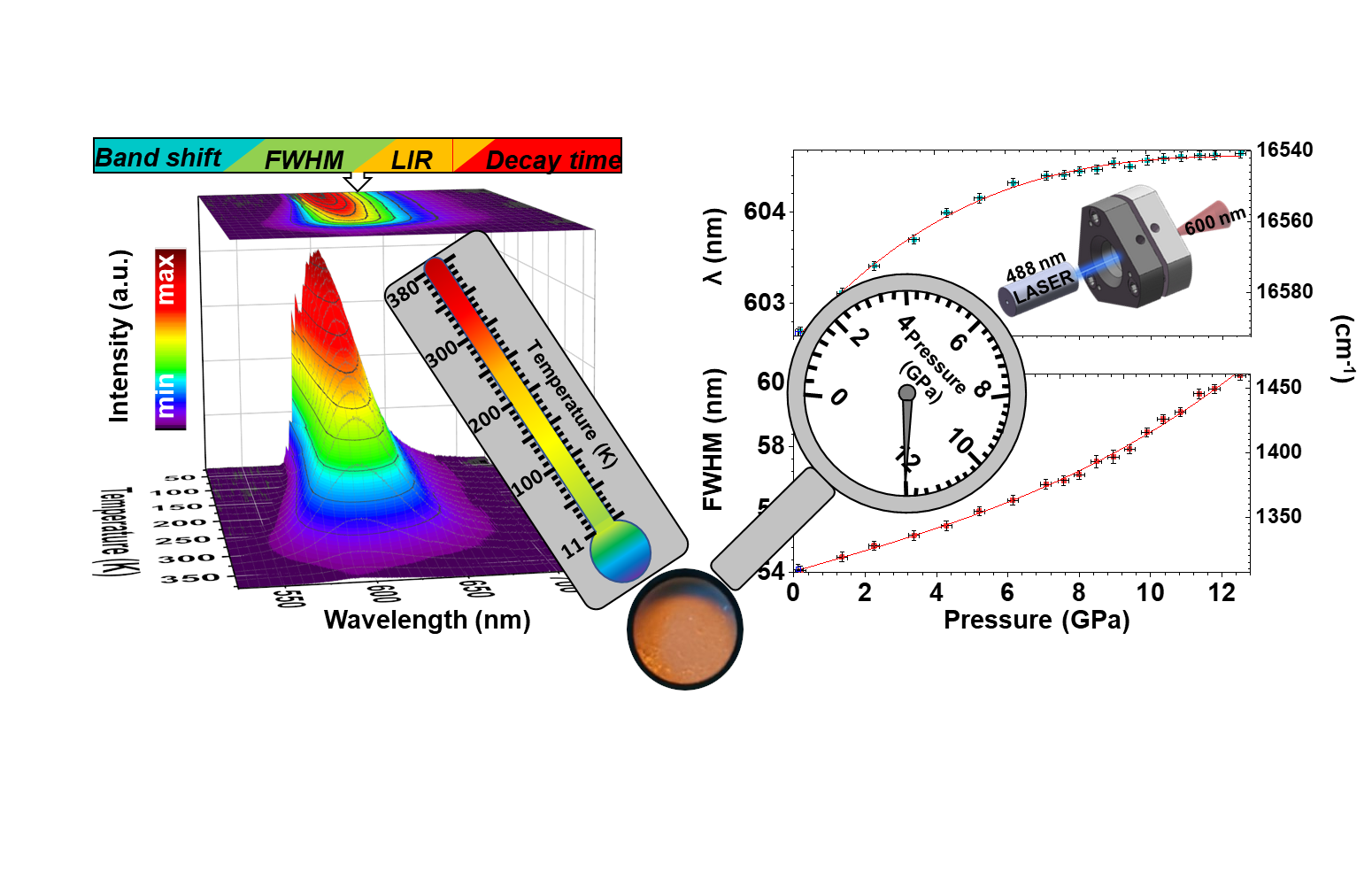
- The work of Sergiusz Napierała, prof. Maciej Kubicki and prof. UAM Monika Wałęsa-Chorab entiteled "Toward Electrochromic Metallopolymers: Synthesis and Properties of Polyazomethines Based on Complexes of Transition-Metal Ions" and the cover of the journal issue illustrating the research described in article have been published in Inorganic Chemistry (ACS, IF = 5.165).
- Team of scientists from Department of Rare Earths has published the paper in Nanoscale (IF = 7.790). This work shows development of inorganic, optical nanothermometer, working in a broad spectral range (vis-NIR), utilizing lanthanide thermally and non-thermally coupled levels for remote temperature detection. They demonstrated how the applied laser power influence on the absolute and relative sensitivities and temperature sensing resolution, which are crucial for luminescence thermometry applications. This effect can be observed in the case of luminescent thermometers exhibiting non-linear phenomena, and using band intensity ratios associated with transitions having different number of photons participating in the relevant radiative processes.
- Inversion tunneling in a symmetric double minimum potential is a challenging large amplitude motion problem which causes all rotational energy levels to split into a symmetric and an antisymmetric level. Not like other types of large amplitude motion such as internal rotation, inversion tunneling appears less often, but the fundamental knowledge gained from this motion is essential to understand the complex structures in coordination chemistry. This review summarizes four most classic examples of molecules featuring inversion tunneling motion and their coordination complexes. The first molecule presented in the paper is a textbook example, ammonia, with its umbrella motion. In the second classic example, methylamine, CH3NH2, the inversion motion of the amino group –NH2 is coupled with a methyl internal rotation –CH3. The third subject is focused on hydrazine with complex internal dynamics governed by three large amplitude motions: two –NH2 tunneling motions and an internal rotation (torsion) of the two amino groups around the N-N bond. Finally, secondary amines feature inversion tunneling of the hydrogen atom attached to the nitrogen, which is accompanied by two methyl internal rotations but not strongly coupled with them so that they can be treated separately.
- An international team of scientists from our faculty (Department of Rare Earths) has published the paper in Advanced Optical Materials (IF = 8.286). Using micron-sized perovskite crystals, a novel strategy in optical thermometry is presented for the first time. The temperature sensing concept is based on the nonlinear processes of second harmonic generation (SHG) and upconversion luminescence (UCL) phenomena. This highly sensitive method exploits a new and effective pathway for contactless temperature sensing – the nonlinear optical thermometry, which is a promising alternative method to conventional luminescence thermometry. The developed sensor is a result of fruitful collaboration of research groups from the Department of Rare Earths, Faculty of Chemistry, Adam Mickiewicz University in Poznań; Universidad de La Laguna, Departamento de Física (Spain); Departament de Química Inorgànica and Institut de Recerca de Química Teòrica i Computacional, Universitat de Barcelona (Spain); Departamento de Química, Universidad Católica del Norte (Chile).
- Phosphorus, occurring mainly in the form of phosphate, is an essential element for the proper functioningof living systems. Phosphate and polyphosphate groups occur as inorganic phosphate (free phosphateanion in solution) and are present in biomolecules such as phosphorylated amino acids, nucleotides,and phytic acid. In solution, phosphates can exist in four different forms depending on pH, and theyare involved in non-covalent interactions with positively charged species. This review summarizes theparticipation of phosphates of nucleotides, phosphorylated amino acids, and phytic acid in weak interac-tions with biogenic amines and in complexes with biometal ions not only in solution but also in solidstate. The study of these processes can enable to understand many of the most important aspects of acell’s life, thus explaining why, for example, abnormal phosphorylation leads to the development of dis-eases, and highlighting the role of phosphates in chemical interactions. In addition, the formation of one-,two-, and three-dimensional polynuclear metal-phosphonate assemblies by phosph(on)ate ligands hasbeen described.
- The work of M.Sc. Maciej Skrodzki, Prof. Violetta Patroniak, Prof. Piotr Pawluć has been published in Organic Letters (ACS, IF = 6.091). Interdepartmental collaboration of Organometallic and Functional Nanostructure Synthesis groups resulted in development of new, highly selective catalytic system for hydrosilylation of alkynes. In contradiction to known hydrosilylation catalysts consisting of noble metals and molecular-heavy and complex ligands, new catalyst is founded on widely abundant metal – cobalt, and simple and rational Schiff Base type ligands. Mild condition, low catalyst loading (5000 - 500ppm), functional group tolerance and compatibility with primary, secondary and tertiary silanes proves uniqueness and yet universality of new catalytic system.
- The article presents the synthesis of core/shell nanoparticles doped with Er3+, Tm3+ or Yb3+ ions and their spectroscopic properties. The obtained nanoparticles show photon up-conversion phenomenon - the property of converting infrared radiation with a wavelength of 808, 975, 1208 or 1532 nm, to radiation with energy higher than the absorbed. What distinguishes this publication from different in the field of up-conversion is the emission of nanoparticles under irradiation with a wavelength other than 975 nm - used the most frequently in other studies. Due to the properties of the lanthanide ions used, emission bands were obtained in a wide spectral range from 475 to 1625 nm, which is important for their use in bioimaging, as well as in anti-counterfeit applications. The selection of ions allowed for the manipulation of energy transfer processes between them, thus obtaining unique spectroscopic properties. Another important feature of the obtained nanoparticles is their intense luminescence, with variable characteristics depending on the wavelength of the excitation radiation.
- The following study presents an analysis of fragrance ingredients used in cosmetics using flowing atmospheric- pressure afterglow mass spectrometry (FAPA-MS). The performance of the method was shown during the determination of fragrance components: patchoulol, farnesol, safrole, geraniol, eucalyptol, and R-carvone. The proposed method offers rapid and reliable analysis, avoiding the pre-separation step and can be an alternative to electronic nose (e-nose) for on-site analysis of cosmetics components. The developed method was used for determination of the fragrance ingredients found in commercial cosmetics and it allowed for fast determination whether a particular fragrance is of high-quality or is it a low-cost alternative product imitating the original.
- The environmental impact of molecularly imprinted polymers (MIPs) was investigated. The molecularly imprinted polymers (MIPs) were synthesized, as templates: herbicides (2,4-dichlorophenoxy acetic acid (2,4-D) or 4-chloro-2-methylphenoxy acetic acid (MCPA)) and flavonoids (rutin (Ru) or quercetin (Q)) were used. Analysis of binding in the molecularly imprinted and non-imprinted polymer (NIP) has proved that MIP shows a higher affinity towards the analytes, compared to NIP. MIPs were used to determine analytes in water using the Flowing Atmospheric-Pressure Afterglow Mass Spectrometry (FAPA-MS) technique. In this approach, the method limit of detection (MLOD) of 2,4-D, MCPA, Ru, and Q in MIP was 4, 3, 10, and 5μg in 1 g MIP, respectively.
The release kinetics of the analytes from MIP and their stability in water was studied. The cultures of Tetradesmus obliquus (Turpin) M.J. Wynne and Daphnia magna Straus were used for in vivo toxicity studies revealing that only Ru-MIP and Q-MIP had negative effect on the living organisms used in the bioassays. - The most recently identified coronavirus, SARS-CoV-2, possesses a threat to human health and life. Although the world has been struggling with the epidemic of the disease it causes, COVID-19, for over a year, there is still no effective drug dedicated to its treatment.
The article discusses, among the others, the life cycle of SARS-CoV-2, potential therapeutic targets (structural proteins and enzymes essential for the viral life cycle), as well as known pharmaceutical agents currently finding new use in COVID-19 treatment trials. The possibility of using therapeutic strategies based on nucleic acid technology or the involvement of human deaminases (APOBEC deaminanses) in the fight against SARS-CoV-2 was also presented. It was indicated that some biologically active natural products may support this fight.
- An international team of scientists from our faculty has published the paper in Journal of Materials Chemistry C (IF = 7.059). For the first time, they have developed the broad-range optical (luminescent) manometer, operating within the unprecedentedly broad pressure range (from 10-4 to 105 bar). The developed sensor allows non-invasively (contactless) monitor pressure of the system, alike in the vacuum and under high-pressure conditions in a diamond anvil cell. The developed sensor is a result of fruitful collaboration of research groups from the Department of Rare Earths, Faculty of Chemistry, Adam Mickiewicz University in Poznań and Faculty of Physics, University of La Laguna in Spain.

- An international team of structural biologists mobilized by Prof. Mariusz Jaskolski (Department of Crystallography) has published a series of high-impact papers on the validation of structural models of SARS-CoV-2 proteins that are potential targets for rational design of COVID-19 drugs. The most recent papers appeared in the crystallographic flagship journal IUCrJ, and are concerned with the structure of 3CLpro, a key enzyme of the SARS-CoV-2 coronavirus (DOI: 10.1107/S2052252521001159), and with the strategy that structural biologists should work out to be prepared for future global health emergencies (DOI: 10.1107/S2052252521003018).
Jaskolski M, Dauter Z, Shabalin IG, Gilski M, Brzezinski D, Kowiel M, Rupp B, Wlodawer A. Crystallographic models of SARS-CoV-2 3CLpro: in-depth assessment of structure quality and validation. IUCrJ, 2021, 8, 238-256. doi: 10.1107/S2052252521001159
Grabowski M, Macnar JM, Cymborowski M, Cooper DR, Shabalin IG, Gilski M, Brzezinski D, Kowiel M, Dauter Z, Rupp B, Wlodawer A, Jaskolski M, Minor W. Rapid Response to Emerging Biomedical Challenges and Threats. IUCrJ 2021, 8. doi: 10.1107/S2052252521003018.
M. Runowski, P. Woźny, K. Soler-Carracedo, A. Lazarowska, M. Kamiński, N. Majewska, A. Muñoz, J. Moszczyński, S. Sobczak, K. Dave, W. Huang, R. Liu , S. Mahlik. Supersensitive visual pressure sensor based on the exciton luminescence of a perovskite material. Mater. Horiz., 2024. doi: https://doi.org/10.1039/D4MH00871E
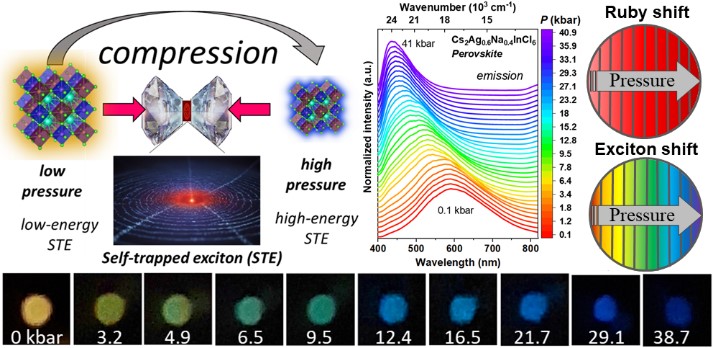
Zeng, Q.; Runowski, M.; Xue, J.; Luo, L.; Marciniak, L.; Lavín, V.; Du, P. Pressure‐Induced Remarkable Spectral Red‐Shift in Mn2+‐Activated NaY9(SiO4)6O2 Red‐Emitting Phosphors for High‐Sensitive Optical Manometry. Advanced Science, 2023, 2308221. https://doi.org/10.1002/advs.202308221.


This work was supported by National Science Center (NCN) under Grant Opus 13 no. UMO-2017/25/B/ST5/00291 and project Preludium 20 no. UMO-2021/41/N/ST4/02137.

This work was supported by National Science Centre (NCN) under Grant Opus 13 no. UMO-2017/25/B/ST5.00291 and project Preludium 20 no. UMO-2021/41/B/ST4/02137.
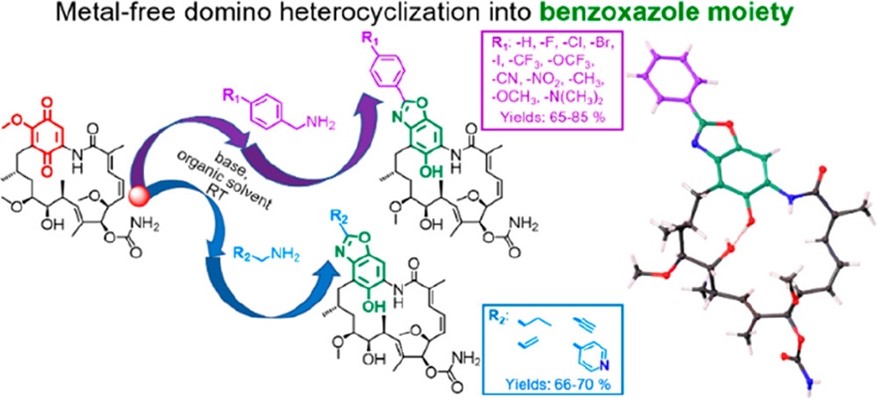
Currently one of the intensively explored areas of research concerns substances capable of controlled and reversible absorption, storage and release of water. Such properties are particularly desirable in, for example, pharmaceutical formulations and desiccants. Most of the known materials of this type release water at higher temperatures, often well above the normal boiling point of water, making the dehydration process expensive and energy-intensive. To make water harvesting from the atmosphere cost-effective, materials are sought that can release water at temperatures only slightly above room temperature.
On April 12, 2023, the journal Nature published a paper entitled "Dehydration of a crystal hydrate at subglacial temperatures," in which scientists from the Adam Mickiewicz and Stellenbosch Universities demonstarted that crystals of a chiral macrocyclic compound, conventionally called trianglimine, have the ability to spontaneously absorb water and release it at sub-zero temperatures. More specifically, the lowest temperature at which this cyclic process can be observed is -70 °C. Below this temperature, the water exists in glass-like state in the hydrate crystals, which is equivalent to losing its ability to flow.
The crystal structure of trianglimine resembles a so-called hollow brick, in which the channel diameter is 1 nm, and the walls are made of macrocycles. The process of water absorption and desorption is visualized as a change in the colour of the crystal from yellow to red and vice versa, which is a consequene of a change in the electron configuration within the macrocycle, associated with reversible proton transfer. Water uptake and realase do not change the crystal structure; the process prooceeds very fast and can be repeated many times without any signs of physical damage to the sample.
The presented research is an important step toward the rational design of materials capable of reversible water capture from the atmosphere, even at low humidity. This is particularly important in so-called arid regions of the world, such as steppes and deserts. Another area of application is humidity indicators for the food and pharmaceutical industries, including the transport and storage of frozen food and vaccines.
Open access to the article is available through the ID-UB program
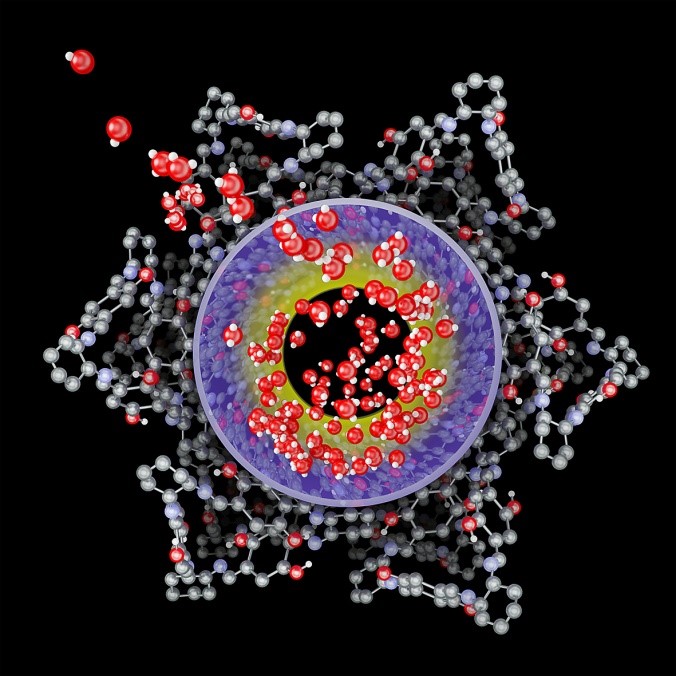

The research was financed by the National Science Center under grant no.: UMO-2017/25/B/ST5/00291 Opus 13.
The research was financed by the National Science Center under grant no.: UMO-2017/25/B/ST5/00291 Opus 13.
The theme of the book are perfluoroalkyl substances (PFAS) - a diverse group of human-made chemicals that are used in a wide range of consumer and industrial products. They are under intense scrutiny due to environmental concerns and there is a call to ban new PFASs entering the market. That said, this book is not intended to wave the banner against PFASs per se; rather it provides a balanced overview of the field, from basic synthesis through to applications, why some current PFASs are and may remain the right substance for the job, as well as addressing the challenges and alternatives.
Covering organofluorine chemistry to fluoropolymers and their applications in various sectors from biomedical to agrochemical, energy and electrical industries, this book is a solid introduction to the topic and demonstrates why fluorinated products are still useful in many domains. With risk assessment and alternatives to PFASs included, it provides a considered account of both the positive applications of PFASs and the pressing environmental concerns.
Suitable for academics and industrial practitioners working in the fields of organic and macromolecular chemistries, it will also appeal to end-users who want to learn about the technology, applications and elimination or recycling of such fluorinated products.
Walkowiak-Kulikowska J., Poly/Perfluorinated Alkyl Substances (PFASs) – Synthetic Methods, Properties and Applications, Perfluoroalkyl Substances: Synthesis, Applications, in: Challenges and Regulations, Royal Society of Chemistry Publishing, 2022, doi.org/10.1039/9781839167591-00022
book: https://pubs.rsc.org/en/content/ebook/978-1-83916-568-9

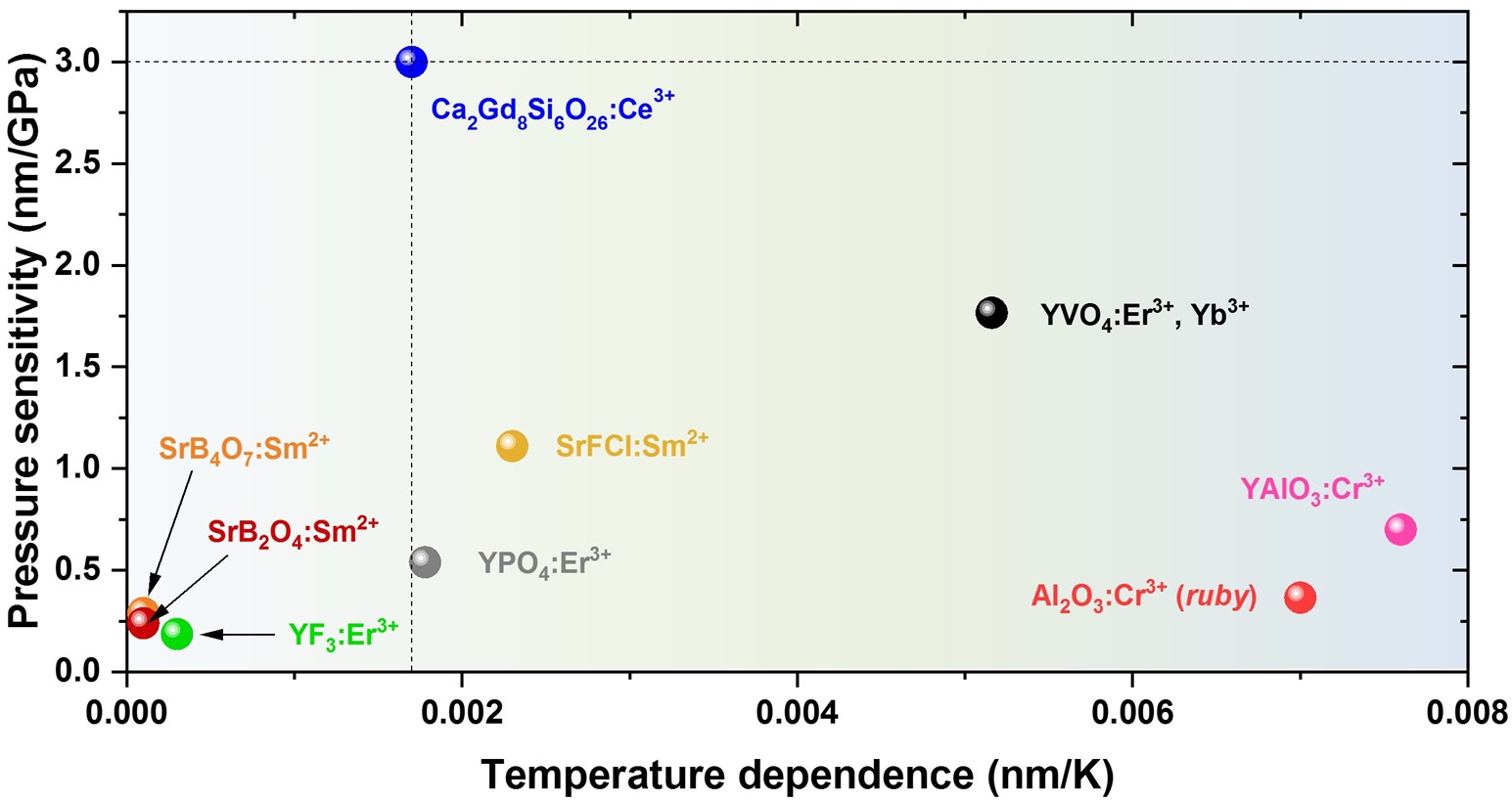

Konopka M., Stefankiewicz A. R., Expanding structural diversity in a library of disulfide macrocycles through in-situ imide hydrolysis, Scientific Reports, 2022, 12, 38. doi:10.1038/s41598-021-03944-y
The article presents a new method of preparation of metallopolymers containing Fe(II) or Cu(II) ions and their electrochromic properties. The metal polymers were obtained in the form of insoluble thin films on the surface of the working electrode as a result of the polycondensation reaction of complexes of transition metal ions containing amino groups and appropriate dialdehydes. It was shown that the polyazomethine obtained by polycondensation of the Fe(II) complex and a dialdehyde containing a triphenylamine group showed a reversible orange to gray color change and good electrochromic stability during multiple oxidation/reduction cycles. The conducted research has shown the usefulness of an on-substrate polycondensation reaction for the preparation of thin films of electrochromic metallopolymers.
Napierała S, Kubicki M, Wałęsa-Chorab M.Toward Electrochromic Metallopolymers: Synthesis and Properties of Polyazomethines Based on Complexes of Transition-Metal Ions. Inorganic Chemistry 2021, 60, 18, 14011-14021. doi: 10.1021/acs.inorgchem.1c01



Skrodzki M, Patroniak V, Pawluć P. Schiff Base Cobalt(II) Complex-Catalyzed Highly Markovnikov-Selective Hydrosilylation of Alkynes. Org. Lett. 2021, 23, 663-667. doi: 10.1021/acs.orglett.0c03721
Grzyb T, Kamiński P, Przybylska D, Tymiński A, Sanz-Rodríguez F, Haro Gonzalez P. Manipulation of up-conversion emission in NaYF4 core@shell nanoparticles doped by Er3+, Tm3+, or Yb3+ ions by excitation wavelength—three ions—plenty of possibilities. Nanoscale, 2021. doi:10.1039/D0NR07136F
Guć M, Cegłowski M, Pawlaczyk M, Kurczewska J, Reszke E, Schroeder G. Application of FAPA mass spectrometry for analysis of fragrance ingredients used in cosmetics. Measurement, 2021, 168, 108326. doi: 10.1016/j.measurement.2020.108326
Guć M, Messyasz B, Schroeder G. Environmental impact of molecularly imprinted polymers used as analyte sorbents in mass spectrometry. Sci. Total Environ., 2021, 772, 145074. doi:10.1016/j.scitotenv.2021.145074

.

